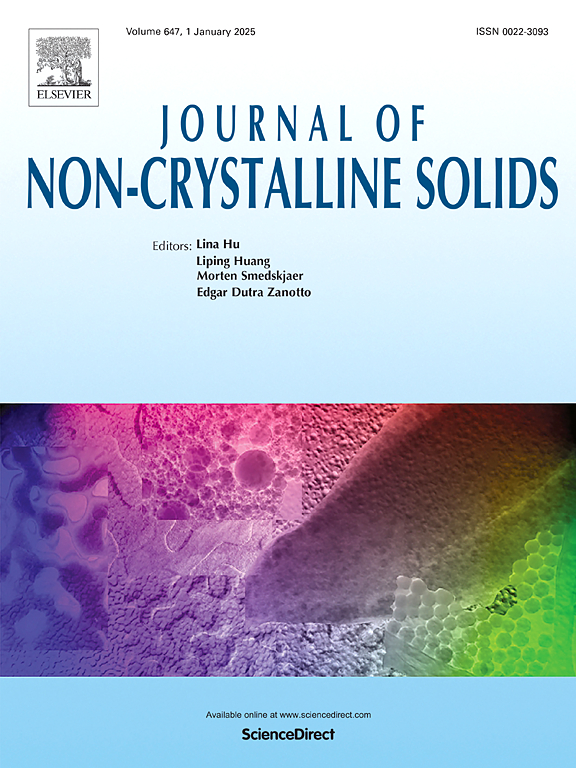Bi₂O₃掺杂对Fe₂O₃-P₂O₅-V₂O₅季系玻璃体系微/纳米力学和介电性能的影响
IF 3.5
3区 材料科学
Q1 MATERIALS SCIENCE, CERAMICS
引用次数: 0
摘要
本文深入研究了Bi2O3掺入对熔体淬火法制备Fe2O3-P2O5-V2O5玻璃的力学性能和介电性能的协同调节作用。详细研究了不同Bi2O3含量(x = 0、0.1、0.2、0.3和0.4)玻璃的显微硬度、纳米硬度和介电性能,以了解Bi2O3是如何引起温度和频率相关的网络修饰的。在力学测试中观察到,Bi2O3的加入提高了玻璃的显微和纳米硬度。显微硬度在x = 0.0时为182 Hv, x = 0.4时为766 Hv,而纳米硬度在191.52 Hv至828.67 Hv之间,反映了玻璃基体内部的致密化和原子堆积的改善。随着Bi2O3含量的增加,弹性模量也有所改善。这些结构增强进一步影响了介电性能,揭示了结构刚度和介电响应之间的相关性。介电常数(ε/)在低频时增加,并随温度的升高保持稳定,在413 K时上升15%;介电损耗(ε//)表明偶极子弛豫在低频时有效,在x = 0.3时表现最佳。通过电介质弛豫活化能评估的离子迁移率和能垒从0.67 eV (x = 0.1)下降到0.49 eV (x = 0.4)。电模量图证实了非德拜弛豫行为;随着Bi2O3含量的增加,损耗模量峰向更高的频率移动。总体而言,本研究表明Bi2O3和Fe2O3由于其结构相容性而增强了玻璃基体的机械稳定性和介电性能。本文章由计算机程序翻译,如有差异,请以英文原文为准。
Impact of Bi₂O₃ doping on micro/nano-mechanical and dielectric properties of Fe₂O₃–P₂O₅–V₂O₅ quaternary glass systems
This paper thoroughly investigates the synergistic effects of Bi2O3 incorporation on adjusting the mechanical and dielectric properties of Fe2O3-P2O5-V2O5 glasses prepared through the melt quenching method. The microhardness, nano-hardness, and dielectric properties of glasses with varying Bi2O3 contents (x = 0, 0.1, 0.2, 0.3, and 0.4) were examined in detail to understand how temperature- and frequency-dependent network modifications are induced by Bi2O3. Evidence of enhanced micro- and nano-hardness in the developed glasses with Bi2O3 addition was observed during mechanical testing. Microhardness ranges from 182 Hv at x = 0.0 to 766 Hv at x = 0.4, while nano-hardness varies from 191.52 Hv to 828.67 Hv, reflecting densification and improved atomic packing within the glass matrix. An improvement in elastic modulus with increasing Bi2O3 content was also noted. These structural enhancements further influenced dielectric properties, revealing a correlation between structural stiffness and dielectric response. The dielectric constant (ε/) increased at low frequencies and remained stable with temperature, showing a 15 % rise at 413 K; dielectric loss (ε//) indicated effective dipole relaxation at low frequencies, with optimal performance at x = 0.3. Ionic mobility and energy barriers, evaluated through dielectric relaxation activation energy, decreased from 0.67 eV (x = 0.1) to 0.49 eV (x = 0.4). Electrical modulus plots confirmed non-Debye relaxation behaviour; loss modulus peaks shifted to higher frequencies with increased Bi2O3 content. Overall, this research demonstrates that Bi2O3 and Fe2O3 enhance the mechanical stability and dielectric performance of the glass matrix due to their structural compatibility.
求助全文
通过发布文献求助,成功后即可免费获取论文全文。
去求助
来源期刊

Journal of Non-crystalline Solids
工程技术-材料科学:硅酸盐
CiteScore
6.50
自引率
11.40%
发文量
576
审稿时长
35 days
期刊介绍:
The Journal of Non-Crystalline Solids publishes review articles, research papers, and Letters to the Editor on amorphous and glassy materials, including inorganic, organic, polymeric, hybrid and metallic systems. Papers on partially glassy materials, such as glass-ceramics and glass-matrix composites, and papers involving the liquid state are also included in so far as the properties of the liquid are relevant for the formation of the solid.
In all cases the papers must demonstrate both novelty and importance to the field, by way of significant advances in understanding or application of non-crystalline solids; in the case of Letters, a compelling case must also be made for expedited handling.
 求助内容:
求助内容: 应助结果提醒方式:
应助结果提醒方式:


